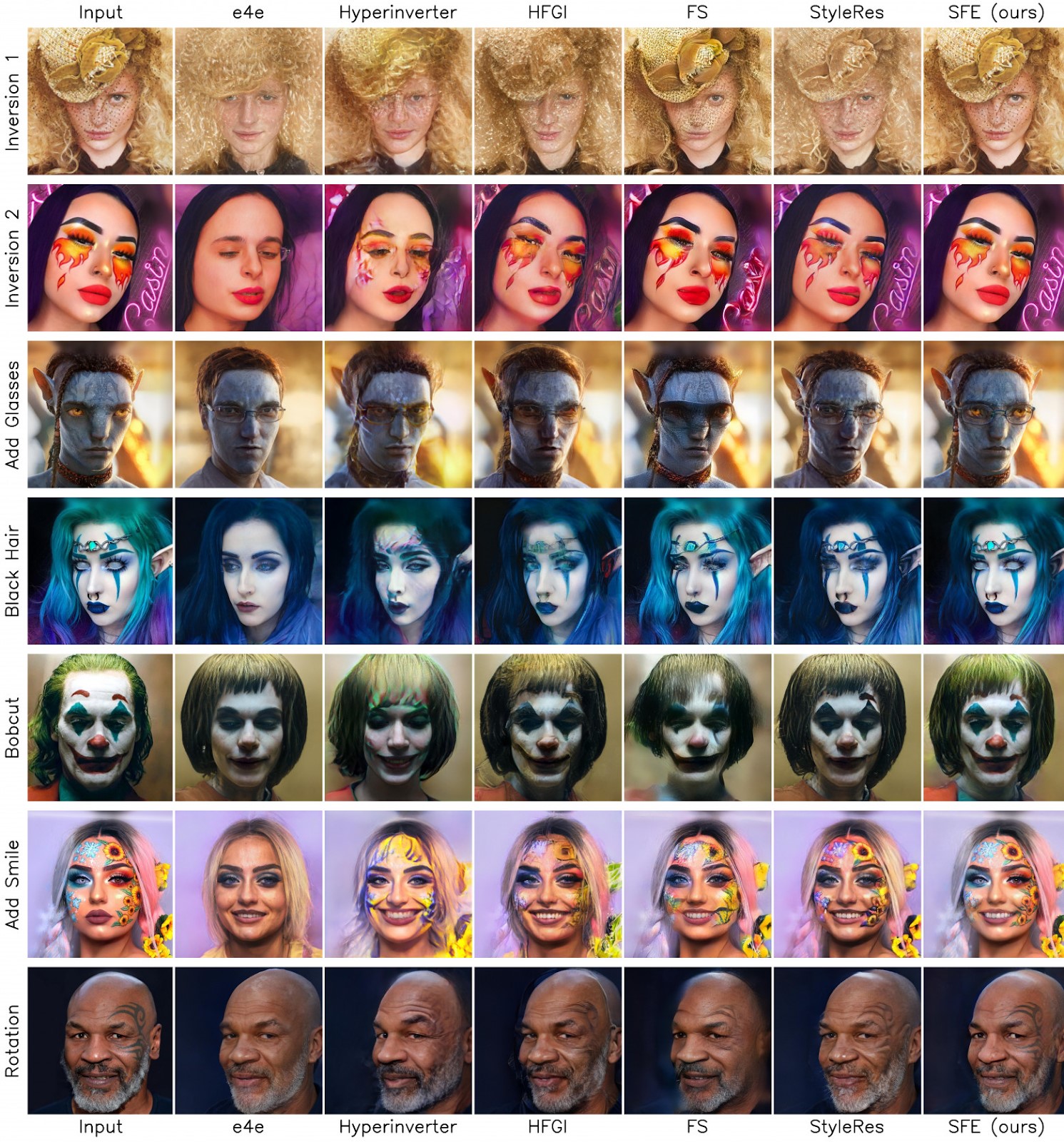Beauty in Details: HSE University and AIRI Scientists Develop a Method for High-Quality Image Editing

Researchers from the HSE AI Research Centre, AIRI, and the University of Bremen have developed a new image editing method based on deep learning—StyleFeatureEditor. This tool allows for precise reproduction of even the smallest details in an image while preserving them during the editing process. With its help, users can easily change hair colour or facial expressions without sacrificing image quality. The results of this three-party collaboration were published at the highly-cited computer vision conference CVPR 2024.
Artificial intelligence is already able to generate and edit images using generative adversarial networks (GANs). The architecture consists of two independent networks: a generator that creates images and a discriminator that distinguishes between real and generated samples. These networks compete with each other, and a new stage in their development is the StyleGAN model. This model can generate images and modify specific parts based on user requests, but it has not been able to work with real photos or images before.
Researchers from the HSE AI Research Centre, the Artificial Intelligence Research Institute (AIRI), and the University of Bremen have proposed a method to quickly and efficiently edit real images. This StyleFeatureEditor approach consists of two modules: the first inverts (reconstructs) the original image, and the second edits this reconstruction. The results of these two steps are passed to StyleGAN, which generates the edited image based on the internal representations. The developers addressed some challenges that had been encountered in previous research. With a small set of representations, the network could edit the image well, but it lost some details from the original. However, with a larger set, all the details were preserved, but the network had difficulty transforming them correctly according to the task.
To solve this, the researchers proposed a new solution: the first module finds both large and small representations, while the second learns how to edit the larger ones using the smaller ones as reference.
However, to train these modules to accurately edit the representations, the neural network requires both real images and their edited versions.
‘We needed examples, such as the same face with different expressions, hairstyles, and details. Unfortunately, such image pairs do not exist at the moment. So, we came up with a trick: using a method that works with small representations, we created a reconstruction of a real image and an example of editing this reconstruction. Although the examples were relatively simple and without details, the model clearly understood how to make the edits,’ explains Denis Bobkov, one of the authors of the article, a research intern at the Centre of Deep Learning and Bayesian Methods of the AI and Digital Science Institute (part of the HSE Faculty of Computer Science), and a Junior Research Fellow at AIRI’s Fusion Brain Lab.
However, training only on generated (simple) examples leads to a loss of detail when working with real (complex) images. To prevent this, the researchers added real images to the training dataset, and the neural network learnt to reconstruct them in detail.
Thus, by showing the model how to edit both simple and complex images, the scientists created conditions under which the network could edit complex images more effectively. In particular, the developed approach handles adding new elements of style while preserving the details of the original image better than other existing methods.

In the case of simple reconstruction (first row), StyleFeatureEditor accurately reproduced a hat, while most other methods almost completely lost it. The developed method showed the best results with additional accessories (third row): most methods could add glasses, but only the StyleFeatureEditor retained the original eye colour.
‘Thanks to this training technique on generated data, we have obtained a model with high editing quality and a fast processing speed due to the use of relatively lightweight neural networks. The StyleFeatureEditor framework requires only 0.07 seconds to edit a single image,’ says Aibek Alanov, Head of the Centre of Deep Learning and Bayesian Methods of the AI and Digital Science Institute (part of the HSE Faculty of Computer Science), and leader of the research group ‘Controlled Generative AI’ at AIRI's Fusion Brain Lab.
The research was funded by a grant from the Analytical Centre under the Government of the Russian Federation for AI research centres.
The research results will be presented at the Fall into ML 2024 conference on artificial intelligence and machine learning, which will take place at HSE University on October 25–26, 2024. Leading AI scientists will discuss the best papers published at top-tier (A*) flagship AI conferences in 2024. A demo of the developed method can be tried out on HuggingFace, and the source code is available on GitHub.
See also:
Habits Stem from Childhood: School Years Found to Shape Leisure Preferences in Adulthood
Moving to a big city does not necessarily lead to dramatic changes in daily habits. A study conducted at HSE University found that leisure preferences in adulthood are largely shaped during childhood and are influenced by where individuals spent their school years. This conclusion was drawn by Sergey Korotaev, Research Fellow at the HSE Faculty of Economic Sciences, from analysing the leisure habits of more than 5,000 Russians.
Russian Scientists Reconstruct Dynamics of Brain Neuron Model Using Neural Network
Researchers from HSE University in Nizhny Novgorod have shown that a neural network can reconstruct the dynamics of a brain neuron model using just a single set of measurements, such as recordings of its electrical activity. The developed neural network was trained to reconstruct the system's full dynamics and predict its behaviour under changing conditions. This method enables the investigation of complex biological processes, even when not all necessary measurements are available. The study has been published in Chaos, Solitons & Fractals.
Scientists Propose Novel Theory on Origin of Genetic Code
Alan Herbert, Scientific Supervisor of the HSE International Laboratory of Bioinformatics, has put forward a new explanation for one of biology's enduring mysteries—the origin of the genetic code. According to his publication in Biology Letters, the contemporary genetic code may have originated from self-organising molecular complexes known as ‘tinkers.’ The author presents this novel hypothesis based on an analysis of secondary DNA structures using the AlphaFold 3 neural network.
See, Feel, and Understand: HSE Researchers to Explore Mechanisms of Movement Perception in Autism
Scientists at the HSE Cognitive Health and Intelligence Centre have won a grant from the Russian Science Foundation (RSF) to investigate the mechanisms of visual motion perception in autism. The researchers will design an experimental paradigm to explore the relationship between visual attention and motor skills in individuals with autism spectrum disorders. This will provide insight into the neurocognitive mechanisms underlying social interaction difficulties in autism and help identify strategies for compensating for them.
Scholars Disprove Existence of ‘Crisis of Trust’ in Science
An international team of researchers, including specialists from HSE University, has conducted a large-scale survey in 68 countries on the subject of trust in science. In most countries, people continue to highly value the work of scientists and want to see them take a more active role in public life. The results have been published in Nature Human Behaviour.
Education System Reforms Led to Better University Performance, HSE Researchers Find
A study by researchers at the HSE Faculty of Economic Sciences and the Institute of Education have found that the number of academic papers published by research universities in international journals has tripled in the past eight years. Additionally, universities have developed more distinct specialisations. Thus, sectoral universities specialising in medical, pedagogical, technical, and other fields are twice as likely to admit students to target places. The study has been published in Vocation, Technology & Education.
Scientists Record GRB 221009A, the Brightest Gamma-Ray Burst in Cosmic History
A team of scientists from 17 countries, including physicists from HSE University, analysed early photometric and spectroscopic data of GRB 221009A, the brightest gamma-ray burst ever recorded. The data was obtained at the Sayan Observatory one hour and 15 minutes after the emission was registered. The researchers detected photons with an energy of 18 teraelectronvolts (TeV). Theoretically, such high-energy particles should not reach Earth, but data analysis has confirmed that they can. The results challenge the theory of gamma radiation absorption and may point to unknown physical processes. The study has been published in Astronomy & Astrophysics.
Chemists Simplify Synthesis of Drugs Involving Amide Groups
Chemists from HSE University and the Nesmeyanov Institute of Organoelement Compounds of the Russian Academy of Sciences (INEOS RAS) have developed a new method for synthesising amides, essential compounds in drug production. Using a ruthenium catalyst and carbon monoxide under precisely controlled reaction conditions, they successfully obtained the target product without by-products or complex purification steps. The method has already been tested for synthesising a key component of Vorinostat, a drug used to treat T-cell lymphoma. This approach could lower the cost of the drug by orders of magnitude. The paper has been published in the Journal of Catalysis. The study was supported by the Russian Science Foundation.
Scientists Examine Neurobiology of Pragmatic Reasoning
An international team including scientists from HSE University has investigated the brain's ability to comprehend hidden meanings in spoken messages. Using fMRI, the researchers found that unambiguous meanings activate brain regions involved in decision-making, whereas processing complex and ambiguous utterances engages regions responsible for analysing context and the speaker's intentions. The more complex the task, the greater the interaction between these regions, enabling the brain to decipher the meaning. The study has been published in NeuroImage.
Scientists Present New Solution to Imbalanced Learning Problem
Specialists at the HSE Faculty of Computer Science and Sber AI Lab have developed a geometric oversampling technique known as Simplicial SMOTE. Tests on various datasets have shown that it significantly improves classification performance. This technique is particularly valuable in scenarios where rare cases are crucial, such as fraud detection or the diagnosis of rare diseases. The study's results are available on ArXiv.org, an open-access archive, and will be presented at the International Conference on Knowledge Discovery and Data Mining (KDD) in summer 2025 in Toronto, Canada.




